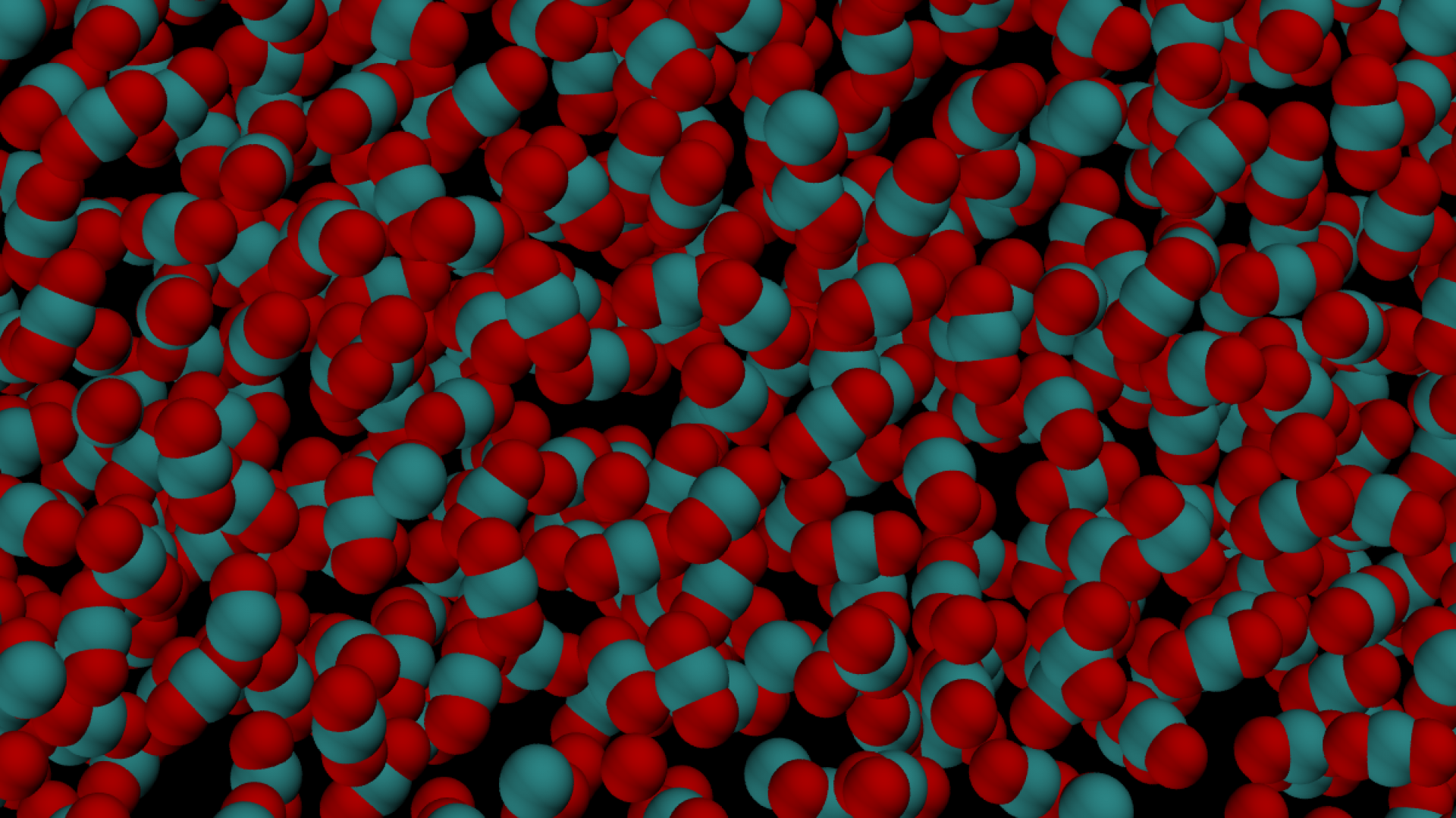For a look at some of our research projects that have been recently completed, check out this page.
Deposition, Growth, and Interfacial Properties of C60 on Pentacene
Electronic Materials
Nanoribbon Materials
Shape Complementarity to Sort Carbon Nanotubes
Titan Photochemistry
Deposition, Growth, and Interfacial Properties of C60 on Pentacene

One promising material for organic semiconductors requires the deposition of C60 layers onto a thin layer of pentacene. Our previous work in this area as studied the characteristics of these C60 molecules as these layers are formed. In particular, the use of kinetic Monte Carlo gave a detailed understanding of the diffusion of C60 between layers. However, a coarse-grained Molecular Dynamics method also provides insight into the growth mechanism while eliminating the need for predefined rates of deposition and diffusion.
Related Publications
Y. M. Acevedo, D. L. Koch, and P. Clancy, Multiscale Simulation and Theoretical Description of Multilayer Heteroepitactic Growth of C60 on Pentacene, Langmuir, 32(12), 3045-3056 (2016).
B. Lin, B. T. Koo, P. Clancy, and C. Hsu, Theoretical Investigation of Charge Transfer Processes at a Planar Pentacene-C60 Interface, J. Phys. Chem.-C, 118, 23605-23613 (2014).
R. A. Cantrell and P. Clancy, A Kinetic Monte Carlo algorithm for heteroepitactic growth: Multilayer C60 growth on pentacene, Journal of Chemical Theory and Computation, 8, 1048-57 (2012).
R.A. Cantrell, C. James, and P. Clancy, Computationally derived rules for the persistence of C60 nanowires on recumbent pentacene bilayer, Langmuir, 27, 9944-9954 (2011)
Electronic Materials
Development of novel semiconductor electronic materials is crucial for scaled-down logic devices. Our work on these electronic materials looked at evaluating properties such as dopant diffusion, identification of impurities, and measuring of contact resistivity, all important for the optimization of semiconductor performance. Using Density Functional Theory, we can study the electronic behavior of particular materials of interest in our group, including β-Ga2O3 and InGaAs.
Related Publications
M. Reveil, J. Wang, M. O. Thompson and P. Clancy, Preferred Diffusional Pathways of Intrinsic Defects and Silicon Dopants in an Ordered Phase of In0.5Ga0.5As: A First-principles Study, Acta Mater., 140, 39-45 (2017).
M. Reveil, J. Wang, M. O. Thompson and P. Clancy, Preferred Diffusional Pathways of Intrinsic Defects and Silicon Dopants in an Ordered Phase of In0.5Ga0.5As: A First-principles Study, Acta Mater., 140, 39-45 (2017).
M. Reveil, H. Huang, H. Chen, J. Liu, M. O. Thompson and P. Clancy, Ab Initio Studies of the Diffusion of Intrinsic Defects and Silicon Dopants in Bulk InAs, Langmuir, 33 (42), 11484-11489 (2017).
J. Wang, B. Lukose, M. O. Thompson and P. Clancy, Ab initio Modeling of Vacancies, Antisites, and Si Dopants in Ordered InGaAs, J. Appl. Phys., 121, 045106 (2017).
Nanoribbon Materials
Synthetic graphene nanoribbons (GNRs) are graphene sheets with widths of only nanometers that are fabricated through synthetic chemistry techniques. These materials have a bandgap comparable to typical semiconductors such as Si, making them suitable for logic and photovoltaic applications. In addition, the GNRs can be functionalized along the edges for a variety of purposes. We are using Molecular Dynamics (MD) to understand how functionalizing the edges effect the colloidal properties of the GNRs in solvent as well as their assembly properties on substrates.
Related Publications
J. D. Saathoff and P. Clancy, Effect of Edge-functionalization on the Ease of Graphene Nanoribbon Aggregation in Solvent, Carbon, 115, 154-161 (2017).
J. Gao, F. Uribe-Romo, J.D. Saathoff, H. Arslan, C. R. Crick, S. J. Hein, B. Itin, P. Clancy, W.R. Dichtel and Y.-L. Loo, Ambipolar Transport in Solution-Synthesized Graphene Nanoribbons, ACS Nano, 10, 4847-4856 (2016).
A. M. Hiszpanski, J. D. Saathoff, L. Shaw, H. Wang, L. Kraya, F. Lüttich, M. Brady, M. L. Chabinyc, A. Kahn, P. Clancy, and Y-L. (Lynn) Loo, Halogenation of a Non-Planar Molecular Semiconductor to Tune Energy Levels and Band Gaps for Electron Transport, Chemistry of Materials, 27, 1892-1900 (2015).
J. D. Saathoff and P. Clancy, Simulation of graphene nanoribbon aggregation in solution and its mediation by edge decoration, J. Phys. Chem. B, 119 (13), 4766-4776 (2015).
Shape Complementarity to Sort Carbon Nanotubes

Because of their outstanding electronic properties, Single-Walled Carbon Nanotubes (SWNTs) are used for a wide range of applications in nanocomposite, optics, sensing, biomedical, and logic circuits. However, a major limitation of deploying these tubes is the coexistence of both semiconducting and metallic species in SWNTs prepared from conventional methods such as chemical-vapor deposition, arc discharge, etc. We conducted Molecular Dynamics study to understand the strong bias of an aromatic molecule, contorted octabenzocircumbiphenyl (c-OBCB), to preferential bind and sort semiconducting SWNTs nanotubes by their chiral angles (matching curvature). This discriminatory binding interaction was reinforced by preferences of the side chains on the c-OBCB to stick to SWNT surface rather than interact with the solvent.
Related Publications
J. Gao, N. Sengar, Y. Wu, S. Jockusch, C. Nuckolls, P. Clancy, and Y.-L. Loo, Contorted Octabenzocircumbiphenyl Sorts Semiconducting Single-Walled Carbon Nanotubes with Structural Specificity. Chem. Mater. 29 (2), 595–604 (2017).
Titan Photochemistry

The lipid bilayer membrane, which is the foundation of life on Earth, is not viable outside of biology based on liquid water. However, it is possible that a different membrane structure could exist at lower temperatures. We propose an azotosome, a membrane composed of small organic nitrogen compounds, that functions in the liquid methane on the moon Titan. Using molecular simulations, we demonstrate that these membranes in cryogenic solvent have an elasticity equal to that of lipid bilayers in water at room temperature.
Related Publications
J.M. Stevenson, W. Foud, D. Shalloway, D. Usher, J. Lunine, W. Chapman and P. Clancy, Solvation of Nitrogen Compounds in Titan’s Seas, Precipitates, and Atmosphere, Icarus, 256, 1-12 (2015).
J.M. Stevenson, J. Lunine and P. Clancy, Membrane alternatives in worlds without oxygen: Creation of an azotosome, Nature Advances, 1 (1) e1400067 (2015).




